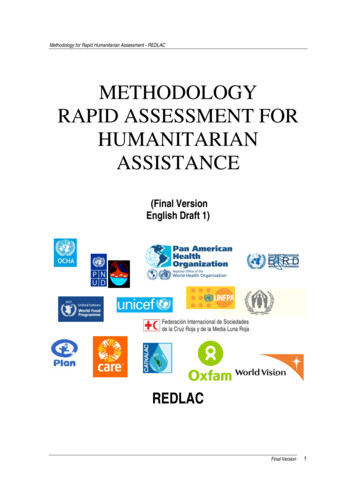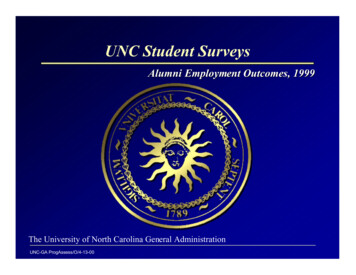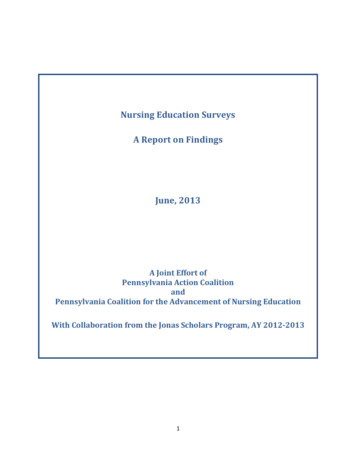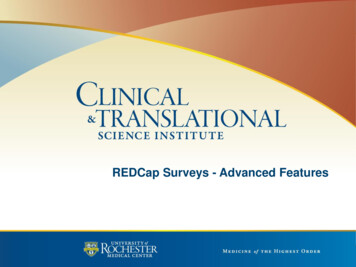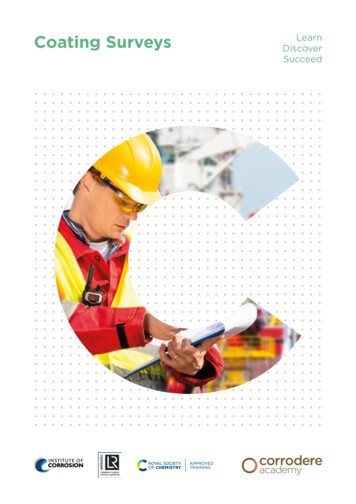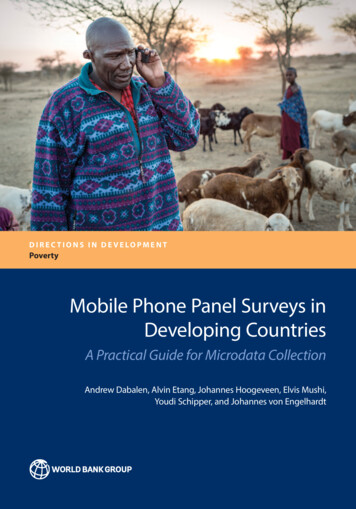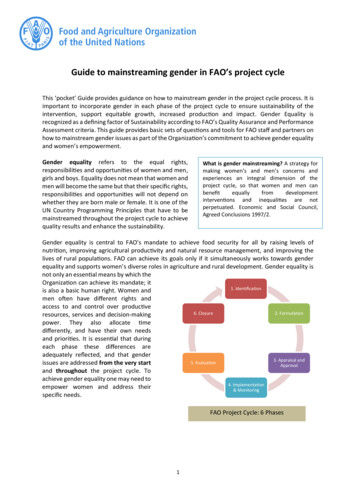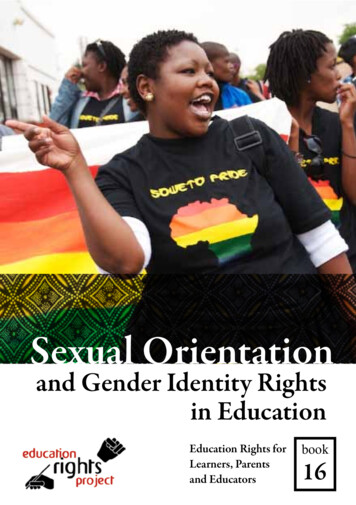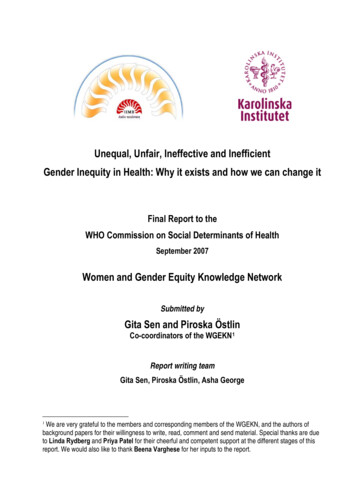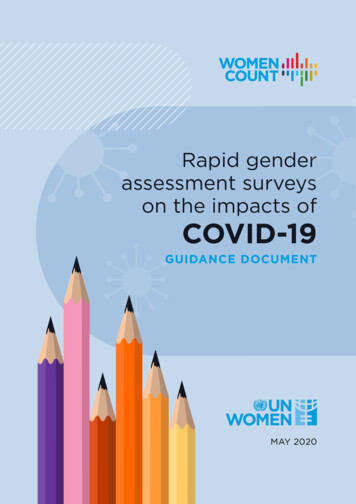
Transcription
Rapid genderassessment surveyson the impacts ofCOVID-19GUIDANCE DOCUMENTMAY 2020
This UN Women guidance document wasdeveloped by the Women Count Team, torespond to the COVID-19 crisis. It was producedunder the overall leadership and guidance ofPapa Seck, Chief Statistician of UN Women. Thereference questionnaire is based on the surveytool developed by the UN Women Asia-PacificRegional Office. The guidance also benefittedfrom the methodological notes of the UNWomen East and Southern Africa RegionalOffice, feedback and inputs from UN Womencolleagues and external partners andstakeholders, and support of Mika Mansukhani,Outreach Specialist, on production. 2020 UN Women. All rights reserved.Produced by the Women Count Team, UN WomenAuthor: Jessamyn EncarnacionCopyeditor: Jen RossDesigner: Meriam Otarra
TABLE OF CONTENTSACRONYMS AND ABBREVIATIONSi1INTRODUCTION12WHY A RAPID GENDERASSESSMENT SURVEY?22.1 What is a rapid genderassessment survey?22.2 Why conduct a rapid genderassessment survey?22.3 How will rapid genderassessment surveys beconducted?3RAPID GENDER ASSESSMENTSURVEY OBJECTIVES ANDMETHODOLOGY43.1 Objectives433.2 Sampling and target population3.3 Reference questionnaire444RAPID GENDER ASSESSMENTSURVEY CONSIDERATIONS64.1 Guidance as a living document64.2 Ethical and safety principles onthe collection of data on genderbased violence64.3 Technical coordination withinUN Women offices64.4 Timing of the RGA74.5 Time frame74.6 Incentives for respondents754.7 Data privacy and legalconsiderations84.8 Publishing results84.9 Costing and finances8OTHER RESOURCES105.1 Electronic and online datacollection105.2 Mobile phone call surveys105.3 Ethical and privacyconsiderations10ANNEXES11Annex 1Strengths and weaknesses of eachdata collection modality11Annex 2Reference questionnaire for a rapidgender assessment survey on theimpacts of COVID-1912Annex 3Reference questions for thematictopics that may be appended to thereference questionnaire of a rapidgender assessment survey on theimpacts of COVID-1921Annex 4Estimated timeline in implementingthe UN Women Rapid GenderAssessment Survey on the impacts ofCOVID-1924
ACRONYMS AND ABBREVIATIONSAPROUN Women Asia-Pacific Regional OfficeCOUN Women Country OfficeCSOCivil society organizationECAROUN Women Europe and Central Asia Regional OfficeESAROUN Women East and Southern Africa Regional OfficeGBVGender-based violenceHQUN Women HeadquartersMOUMemorandum of UnderstandingNGONon-governmental organizationNSONational statistics officeRGARapid gender assessmentROUN Women Regional OfficeSMSShort message serviceTORTerms of referenceUSDUnited States dollarsUSSDUnstructured Supplementary Service DataWomenCountMaking Every Woman and Girl CountRAPID GENDER ASSESSMENT SURVEYS ON THE IMPACTS OF COVID-19 i
INTRODUCTIONThis guidance document on implementing rapidgender assessment surveys on the impacts ofCOVID-19 was developed by UN Women’s globalgender data programme, Making Every Womanand Girl Count (Women Count),1 to increasethe programme’s relevance in response to theCOVID-19 crisis, while continuously delivering onits core objectives.It provides support for UN Women colleaguesin Regional and Country Offices (ROs & COs)and others seeking to integrate the genderedimpacts of COVID-19 into their work and to betterunderstand COVID-19’s disproportionate impactsand implications for women and girls. It explainswhy gendered impact analysis is important;provides core as well as thematic questionsrelating to the gendered impacts of COVID-19;and offers a sample/reference questionnaire,including tips and guidance. The questionnaireprovides simple, straightforward questions on:1) core topics strongly suggested to be asked byall UN Women ROs and COs implementing thesesurveys; and 2) thematic topics that ROs and COsmay opt to ask, depending on their area-specificpriorities and programmes. These are expectedto result in rapid outputs for those who intendto improve the design and outcomes of postCOVID-19 programmes and interventions, policyand decision-making.UN Women. Making Every Woman and Girl Count. Accessed 2April 2020. https://data.unwomen.org/women-count1RAPID GENDER ASSESSMENT SURVEYS ON THE IMPACTS OF COVID-19 1
WHY A RAPID GENDERASSESSMENT SURVEY?2.1 What is a rapid gender assessment survey?Rapid assessment surveys can be used togather information on knowledge, attitudes,skills and behaviours related to a thematictopic in a community. As with most tools usedin community development programmes,a single rapid assessment, while useful as aformative exercise, does not have the same highstandards of scientific rigour. Instead, carryingout several such assessments over time orwith different groups is likely to yield sufficientinsights for effective campaign-planning andimplementation.2Specifically, the rapid gender assessment (RGA)surveys on COVID-19 undertaken by UN Womenseek to make visible and improve understandingof the gendered impacts of COVID-19 in families,communities and society in general, to enable theidentification of problems and their solutions. TheRGAs are intended to be simple, low-cost, quick touse and easy to integrate into existing exercisesfor programme design or monitoring.32.2 Why conduct a rapid gender assessment survey?By 29 May 2020, world COVID-19 confirmedcases surpassed 5.8 million4. Without data thatis disaggregated by sex, these numbers give usonly part of the story. They are insufficient forunderstanding the unique impact of the crisison women as compared to men. We need farmore sex-disaggregated data to tell us how thesituation is evolving, including on differing ratesof infection, economic impacts, differential careburdens, and difficulties in accessing basic goodsand services.UN Women. Virtual Knowledge Centre to End Violenceagainst Women and Girls. Accessed 6 April 2020. ssessment-surveys-and-mini-surveys.html.4UN Women. Women Count Data Hub. Accessed 29 May gnizant of this imperative, UN Women isleading global data-collection efforts to closethis information and knowledge gap. In line withthis, UN Women field offices are thus called onto conduct rapid gender assessment surveys toensuring that all people, particularly the mostvulnerable, are accounted for. Partnership withthe public sector and non-State actors on thesedata-collection efforts is likewise encouraged.23Oxfam. Participatory Methodology: Rapid Care Analysis.Guidance for Managers and Facilitators. Accessed 2 April -620147.RAPID GENDER ASSESSMENT SURVEYS ON THE IMPACTS OF COVID-19 2
2.3 How will rapid gender assessment surveysbe conducted?2.3.1In terms of primary data collectionGiven the nature of COVID-19 and the relatedmobility restrictions, conventional ways ofcollecting data and information, such as face-toface interviews with groups or individuals, arepresently not appropriate or feasible.Several data-collection options are presented,focusing on the use of electronic, Internet,telephone and mobile phone-based data sources.Regions and countries will choose the modalitydepending on what is most feasible to them:1) Phone-call survey2) Online survey administered through a webbrowser, with notification of the survey sentvia short message service (SMS)3) Survey directly administered via SMS.These can be done either as a stand-alone surveyor a module on COVID-19 integrated within asurvey that is being planned or executed. Mindfulthat there is no one (perfect) way of conductingthis survey, Annex 1 summarizes the strengths andweaknesses of each modality, as determined bythe UN Women East and Southern Africa RegionalOffice (ESARO). It will thus be important for UNWomen Regional and Country Offices to carefullyconsider each of these, before choosing the surveymodality most suitable to their circumstances.Further, through the Women Count programme,UN Women works with national statistical offices(NSOs) in strengthening their capacities for betterand more gender-responsive data collection.2.3.2In terms of partnerships andcollaborationWhether UN Women enters into a partnershipagreement will vary from country to country.Doing this jointly with the UN Country Teamor other UN agencies will have the advantageof greater collaboration and reduction ofpotential duplication. Partnerships with civilsociety organizations (CSOs), non-governmentalorganizations (NGOs), and the private sectorwill help during advocacy and programmeimplementation, as there will be a smoothtransition from the needs identification phaseto the planning phase. The advantage of apartnership with government, such as an NSOand/or gender machinery, will be the leveragingof government expertise and resources as wellas fostering buy-in and promoting the use of thedata in strategy and programme formulation.The aforementioned possibilities are not mutuallyexclusive – that is, UN Women may engage withmore than one of these partners for the samesurvey.RAPID GENDER ASSESSMENT SURVEYS ON THE IMPACTS OF COVID-19 3
RAPID GENDER ASSESSMENTSURVEY OBJECTIVES ANDMETHODOLOGY3.1 ObjectivesThe general aim of the survey is to provideinformation on how the livelihoods andcircumstances of women and men are affectedby COVID-19. The results of the survey will alsoinform UN Women’s own programming torespond to the crisis and advocacy to improve thewell-being of women and girls – during and postpandemic.Considering region- and country-specific prioritiesand needs, specific objectives may vary slightly,but it is expected that the general objectivesmentioned above should be maintained andfollowed.3.2 Sampling and target populationSampling will depend on the implementing UNWomen Regional and Country Offices’ objectivesand resources. However, usually, the RGA willuse a simple random sampling technique from arespondent database – a list of mobile subscribers– in the country conducting the survey. Thesample should be nationally representative – byage, gender, geographical location, and to theextent possible, education. On the last point,while SMS surveys are generally able to reachwide portions of the population, the sample isusually made up of literate adults with accessto mobile phones, and thus reaches wealthierpopulations than other modes such as phone-callsurveys.Within the COVID-19 context of limited mobility,these surveys are very much limited by the datacollection modalities. In the example above,results will be representative of the populationof phone subscribers only. In as much as UNWomen would like to make surveys as nationallyrepresentative as possible, presently, they are theonly available option.3.3 Reference questionnaireThe questionnaire or survey tool is aimed atrapidly taking stock of changes experiencedat individual and household levels as a resultof COVID-19. Given time-frame limitations, itcannot provide data that reflect the situationof the whole population. As a rapid assessment,the focus is therefore not on exact measures,but rather relative change since the onset ofCOVID-19.The questionnaire must be short and concise tominimize respondent fatigue. The general aimis for the respondent not to take longer than 15minutes to complete the questionnaire.A reference questionnaire has been developed topromote comparability and for ease of referenceby UN Women colleagues. This is based on the UNWomen Asia-Pacific Regional Office questionnaire,which first initiated and rolled-out a RGA. Severalmodifications and additions have been introducedbased on the questionnaires developed by UNWomen ESARO and the Europe and Central AsiaRegional Office (ECARO), as well as inputs andRAPID GENDER ASSESSMENT SURVEYS ON THE IMPACTS OF COVID-19 4
suggestions by Women Count Headquarters (HQ).The reference questionnaire provides simple,straightforward questions both on: 1) core topicsstrongly suggested to be asked by all regionsand country offices implementing the surveys(Annex 2); and 2) thematic topics that regionsand countries may opt to ask, depending on theirarea-specific priorities and programmes (Annex 3).The RGA covers the following common themes:employment and livelihood resources, knowledgeon COVID-19, access to basic goods and services, andunpaid care and domestic work. Additional themesmay include the following: feelings of safety, copingmechanisms and household food production.Annex 2 presents the reference questionnairecovering the core questions strongly suggested tobe asked by all implementing UN Women RO andCOs. Annex 3 provides the suggested questionson select thematic topics that may be added,depending on the implementing party.Presently, the reference questionnaire is inEnglish. Depending on the dominant language/sused in a country, it may be necessary to translateor contextualize the questions based on thecountry context prior to rolling out the survey.RAPID GENDER ASSESSMENT SURVEYS ON THE IMPACTS OF COVID-19 5
RAPID GENDER ASSESSMENTSURVEY CONSIDERATIONS4.1 Guidance as a living documentThis guidance document is not the be-all andend-all on the how-to of conducting an RGA onthe impacts of COVID-19. This should be treatedas dynamic document that should be continuallyupdated as UN Women ROs and COs implementRGAs and discover and learn better and/or newways of how to do things.As more countries conduct RGAs, this documentshould be enriched by helpful inputs, resources,as well as learnings from the earlier group ofUN Women ROs and COs. Thus, the additionalcountries will be better informed – not only withthe help of this guidance document but, equallyimportantly, with the experiences of the earliergroup of countries.4.2 Ethical and safety principles on the collection of dataon gender-based violenceUN Women certainly recognizes the importanceof monitoring evidence of the impact of COVID-19on the incidence of gender-based violence (GBV)and sexual abuse,
2.2 Why conduct a rapid gender assessment survey? By 29 May 2020, world COVID-19 confirmed cases surpassed 5.8 million4. Without data that is disaggregated by sex, these numbers give us only part of the story. They are insufficient for understanding the unique impact of the crisis on women as compared to men. We need far more sex-disaggregated data to tell us how the situation is evolving .

